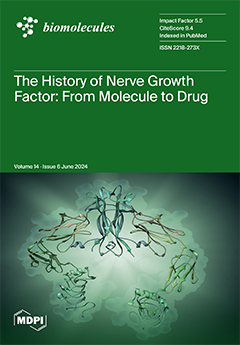The active form of vitamin D
3, 1α,25-dihydroxyvitamin D
3 [1,25(OH)
2D
3], is a principal regulator of calcium homeostasis through activation of the vitamin D receptor (VDR). Previous studies have shown that 2α-(3-hydroxypropyl)-1,25D
3 (O1C3) and 2α-(3-hydroxypropoxy)-1,25D
3 (O2C3),
[...] Read more.
The active form of vitamin D
3, 1α,25-dihydroxyvitamin D
3 [1,25(OH)
2D
3], is a principal regulator of calcium homeostasis through activation of the vitamin D receptor (VDR). Previous studies have shown that 2α-(3-hydroxypropyl)-1,25D
3 (O1C3) and 2α-(3-hydroxypropoxy)-1,25D
3 (O2C3), vitamin D derivatives resistant to inactivation enzymes, can activate VDR, induce leukemic cell differentiation, and increase blood calcium levels in rats more effectively than 1,25(OH)
2D
3. In this study, to further investigate the usefulness of 2α-substituted vitamin D derivatives, we examined the effects of O2C3, O1C3, and their derivatives on VDR activity in cells and mouse tissues and on osteoblast differentiation of dedifferentiated fat (DFAT) cells, a cell type with potential therapeutic application in regenerative medicine. In cell culture experiments using kidney-derived HEK293 cells, intestinal mucosa-derived CaCO
2 cells, and osteoblast-derived MG63 cells, and in mouse experiments, O2C2, O2C3, O1C3, and O1C4 had a weaker effect than or equivalent effect to 1,25(OH)
2D
3 in VDR transactivation and induction of the VDR target gene
CYP24A1, but they enhanced osteoblast differentiation in DFAT cells equally to or more effectively than 1,25(OH)
2D
3. In long-term treatment with the compound without the medium change (7 days), the derivatives enhanced osteoblast differentiation more effectively than 1,25(OH)
2D
3. O2C3 and O1C3 were more stable than 1,25(OH)
2D
3 in DFAT cell culture. These results indicate that 2α-substituted vitamin D derivatives, such as inactivation-resistant O2C3 and O1C3, are more effective than 1,25(OH)
2D
3 in osteoblast differentiation of DFAT cells, suggesting potential roles in regenerative medicine with DFAT cells and other multipotent cells.
Full article






